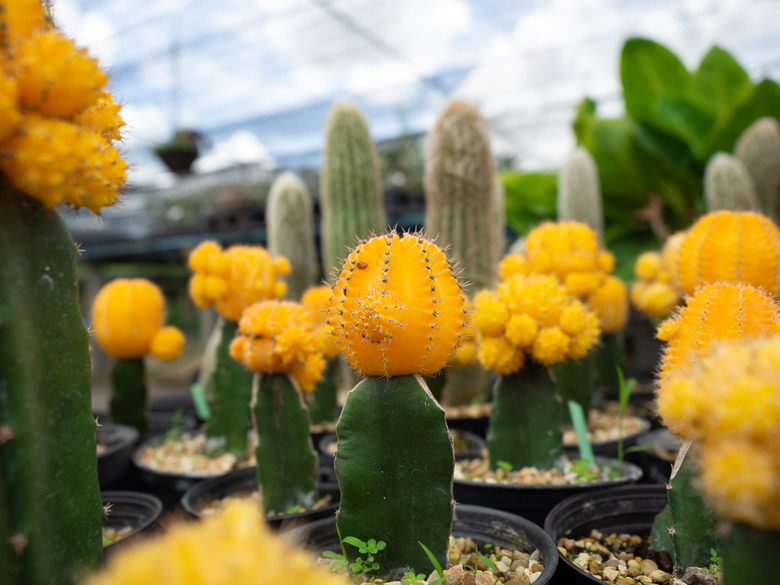How Big Do Moon Cactus Grow?
We may receive a commission on purchases made from links.
They say teamwork makes the dream work, and that's particularly true when it comes to the moon cactus (Gymnocalycium mihanovichii, U.S. Department of Agriculture plant hardiness zone 10). Horticulturists believe that these beautiful cactus plants, known for their colorfully flowered tops, stem from a 1940 mutation that lethally damaged the plants. The mutated plants showed brilliant red and yellow flowers, but were unable to produce the chlorophyll needed for photosynthesis.
To solve this problem, clever gardeners grafted moon cacti onto other cacti, usually using a dragon fruit (Selenicereus undatus, formerly Hylocereus undatus, USDA zones 9 through 11) as the base, although other varieties can work. There are now at least 16 different colors of moon cactus, all of which are actually two plants joined together.
Tip
Although the height of a moon cactus depends on the rootstock it's grafted to, most grow no taller than around 12 inches.
How High Will It Grow?
How High Will It Grow?
How tall a moon cactus grows depends on the type of cactus rootstock it was grafted to. Generally, however, a moon cactus won't get much taller than about 12 inches. The plant's colorful flowers grow to a width of about 4 inches, remaining the size of a golf ball throughout their lives. Most never need to be transplanted to anything larger than a 4-inch pot.
Your moon cactus will keep its colorful top throughout its life, but note that its lifespan will be relatively short. Many species of cacti can survive for decades, but the moon cactus isn't one of them. Because this is a joining of two plants, most only survive about two to three years. Some savvy gardeners have, however, kept a moon cactus alive for five years or more.
Caring for a Moon Cactus
Caring for a Moon Cactus
To keep this charming plant vibrant for as long as possible, try to provide optimal growing conditions. Place your cactus where it will get copious amounts of indirect sunlight. The moon cactus often grows in the shadow of another cactus, so full sun could burn your plant, hurting it more than it helps.
Water the plant sparingly and make sure that you place it in a pot with adequate drainage. If, like most people, you grow the moon cactus as a houseplant, keeping the plant at room temperature all year is perfect. If you want to move your cactus outside, bring it back in whenever the temperature drops below about 40 degrees Fahrenheit. Your plant will rest in the winter, but you should provide liquid cactus fertilizer every four to eight weeks during the growing season — from April to September.
Grafting a Moon Cactus
Grafting a Moon Cactus
If you've got a moon cactus in a color you love, or one that has sentimental value, you can try grafting it to a new rootstock to prolong its life. The reason moon cacti don't live long is that they're grafted to rootstock that eventually dies. If you place the moon cactus on another root, you can prolong its life.
To do so, cut off the top of the plant you wish to use as the base. Make a clean cut using a sharp, nonserrated knife. Make the cut 2 or 3 inches above the soil. Now cut your moon cactus off its old rootstock as close to the top as you can. Again, a clean cut with a nonserrated blade is necessary.
Look inside both cut cacti and you'll see little tubes. These tubes act like blood vessels to the plant, carrying nutrients where they need to go. If you can, line up these tubes as much as possible when placing the moon cactus on the new rootstock. Then, use a rubber band around the top of the cacti and the bottom of the pot to hold the moon cactus in place. In a few weeks, the plants will have grown together and you can remove the rubber band.
References
- Sublime Succulents: How to Graft Cacti
- University of Arkansas Research & Extension: Plant of the Week: Grafted Cactus, Neon Cacti, Moon Cactus, Hibotan Cactus
- Garden Lovers Club: How to Grow and Care for Moon Cactus
- Succulent Alley: How Big Do Moon Cactus Get?
- Clemson Cooperative Extension: Indoor Cacti
- Mountain Crest Gardens: Gymnocalycium mihanovichii – Grafted Moon Cactus
- National Gardening Association: Dragon Fruit (Hylocereus undatus)
